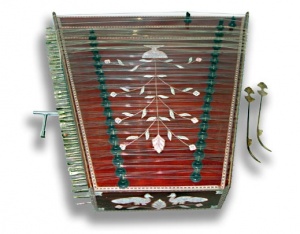Santoor
The santoor is a trapezoid-shaped hammered dulcimer often made of walnut, with seventy strings. The special-shaped mallets (mezrab) are lightweight and are held between the index and middle fingers. A typical santoor has two sets of bridges, providing a range of three octaves.
The santoor is a hammered dulcimer, derived from the Persian santur (which is believed to be the first instrument of its type), and related to similar instruments in Iraq, Pakistan, Armenia ,Turkey, and other parts of Central Asia. It was called the shata-tantri veena in earlier times.
The Indian santoor is more rectangular and can have more strings than the original Persian counterpart, which generally has 72 strings. The santoor as used in Indian classical music is played with a pair of curved mallets made of walnut wood and the resultant melodies are similar to the music of the harp, harpsichord or piano. The sound chamber is also made of walnut wood and the bridges are made of local wood and painted dark like ebony. The strings are made of steel from Germany and England.
Notable santoor players of the twentieth century include Pandit Shivkumar Sharma and Pandit Bhajan Sopori.
The younger generation of santoor players include Rahul Sharma and Abhay Rustum Sopori, Saurav Chatterjee, and many other prominent names like Kakan Ghosal, Versha Aggarwal, Roshan Ali, Satish Vyas, Harjinderpal Singh, and Kiranpal Singh of London U.K. and Sandip Chatterjee.
Development
The santoor was a part of the classical music of Kashmir in India. It was a 100 stringed instrument played in a style of music known as the Sufiana Mausiqi. The Sufi mystics used it as an accompaniment to their hymns.
For an instrument to be accepted as classical it has to be able to emulate the human voice, the ultimate classical instrument. This requires the effect of meend (glissando), which is the ability to pass, unbroken, from one note to another, as opposed to staccato.
Anatomy of the santoor
The santoor is basically made out of wood. The framework is generally made out of either walnut or maple wood. The top and bottom boards sometimes can be either plywood or veneer. On the top board, also known as sound board, wooden bridges are placed, in order to seat stretched strings across. The strings are tied on nails or pins on the left side of the instrument and are stretched over the sound board on top of the bridges to the right side.
On the right side there are steel tuning pegs or tuning pins, as they are commonly known, that allows tuning each individual string to a desired musical note or a frequency or a pitch. The santoor is a unique Indian string instrument that is not plucked or bowed but is played with a pair of light wooden mallets or hammers. The santoor is played while sitting in an asana called Ardha-sampadha position and placing it on top of the lap.
The santoor is a flat shaped instrument in the form of a trapezoid that means it is wider at one end and short at the other end. It is a wooden box that is broader in size for base notes or low pitch notes and is tapered at the other side for the high-pitched notes. While playing, the broad side is closer to the waist of the musician and the shorter side is away from the musician. Both left and right hands are used to lightly strike the strikers on the strings. One can also choose to skilfully glide the strikers on the strings.
In any case, the santoor is a very delicate instrument and is very sensitive to such light strokes and glides. The strokes are played always on the strings either closer to the bridges or a little away from bridges. Both styles result in different tones. Sometimes strokes by one hand can be muffled by the other hand by using the face of the palm just to create a variety.
| Kirtan: | Raga · Taal · Ragmala · Classical Music · Sangeet · Dhuni · Divan · Asa di Var · Jatha · Simran · Shabad · Tuk · Rababi · Dhadhi |
| Ragas: | Asa · Bairari · Basant · Bhairon · Bihagara · Bilaval · Devagandhari · Dhanasari · Gauri · Gond · Gujari · Jaijavanti · Jaitsri · Kalian · Kanara · Kedara · Maajh · Malaar · Mali Gaura · Maru · Nat Narain · Prabhati · Ramkali · Sarang · Sri · Sorath · Suhi · Tilang · Todi · Tukhari · Vadahans |
| Ragis: | Harjinder Singh · Maninder Singh · Amolak Singh · Darshan Singh · Balwinder Singh · Harbans Singh · Anoop Singh · Niranjan Singh · Amrik Singh · Avtar Singh · Snatam Kaur ·Kamaljit Kaur · Dileep Kaur · Joginder Singh · SS Maskeen |
| Saaj: | Harmonium · Tabla · · Tanpura · Taus · Rabab · Sarangi · Dilruba · · Saranda · Sarode · Sitar · Santoor · Pakhawaj · Dhadh · Dholak · Dool |

